Table of contents
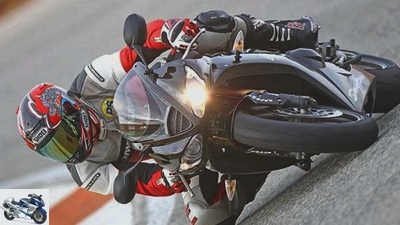
Critchell
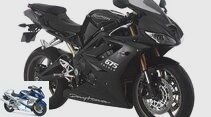
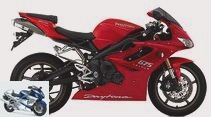
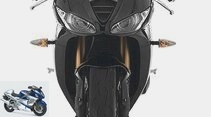

9 pictures

triumph
1/9
Triumph Daytona 675
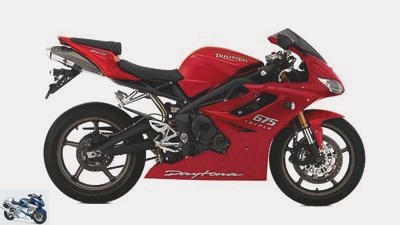
triumph
2/9
Triumph Daytona 675
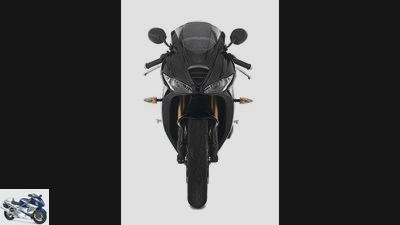
triumph
3/9
Triumph Daytona 675
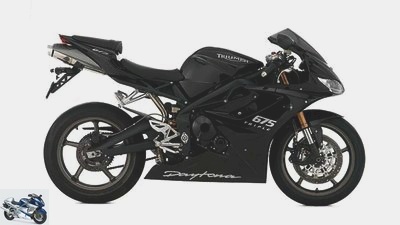
triumph
4/9
Triumph Daytona 675
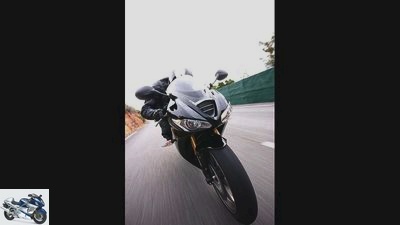
triumph
5/9
Triumph Daytona 675
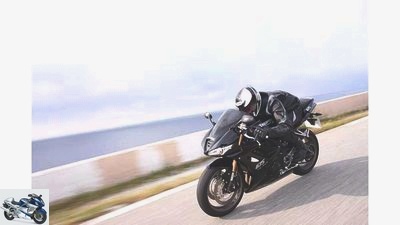
triumph
6/9
Triumph Daytona 675
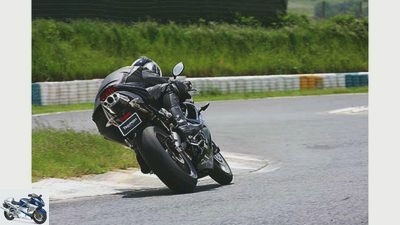
triumph
7/9
Triumph Daytona 675
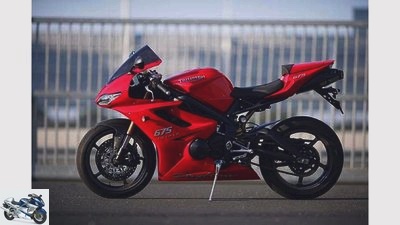
triumph
8/9
Triumph Daytona 675
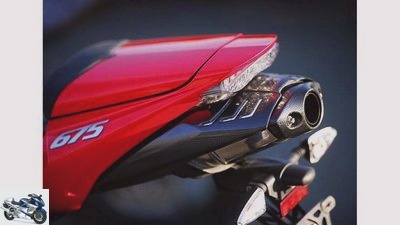
triumph
9/9
Triumph Daytona 675
motorcycles
Premiere Triumph Daytona 675
Premiere Triumph Daytona 675
Business as usual
Content of
Three years after its premiere, the Triumph Daytona 675 was extremely successful in the supersport segment. But before anything goes wrong, it will be revised in the dealers’ showrooms in 2009. PS found out how the hare is going.
Uwe Seitz
January 16, 2009
Business as usual
Exciting, isn’t it? The Triumph contains more than 50 changes to its predecessor Daytona 675 of the year 2009. So it says in bold in the prospectus; a nice appetizer. But slowly! You shouldn’t be too naive about it now. Experience teaches us that on a device as complex as a supersport motorcycle, 50 things or more can quickly be changed without anything serious happening. That in turn can be good or bad, which not least also depends on whether the predecessor was a grenade or a lemon.
The Daytona 675’s record clearly shows it to be the former: IDM title, victory in France and England as well as hardly a comparison test that it would not have won. So there is no reason to throw everything overboard. So the over 50 changes mean “business as usual” or “filing instead of chopping off”. And as we love it so much with super sports enthusiasts, some measures were immediately reflected in increased performance. 3 HP are said to have been added, so that the new 128 instead of the previous 125 HP pulls out. The goal was more top performance without curtailing the highly praised pull of the predecessor. At least the latter seems to have succeeded, because on the Cartagena race track the new 675 shone like its predecessor at the exit of a curve, even when the aisles were not so neatly sorted. While the 600 competition almost refuses to work after such mistakes, the Daytona feels like the good Samaritan. From around 5500 rpm there is clear propulsion, after which the Triumph lashes forward more and more powerfully. That also speaks for super athletes on the country road. The triplet also turns 400 rpm higher in 2009. The fact that it now marches to just under 14,000 rpm saves the next higher gear on the intermediate spurt out to the next bend, especially on winding routes such as in Cartagena. In any case, the Triumph takes on the gas with a noticeably gentle response, which has not always worked so well in the past.
Weight, chassis, brakes
This positive impression is also evident when it comes to handling: the new weighs 3 kilograms less, which means 162 kg dry weight. On the silencer alone, the engineers saved a little over 1 kg by using thinner sheet metal and changing the innards. The rear wheel including the pinion has also become a little more than 1 kg lighter. In addition, there are impeccable Pirelli Diablo Supercorsa SP, and the Daytona willingly throws itself into the bend, masters turning in the narrow chicane with the gas tap open and reacts directly, but not nervously, to course corrections in the long curves. Even on the brakes, the 675 turned neutrally. Speaking of brakes: They are also among the more than 50 goodies of the new? in the truest sense of the word, because the radially mounted monoblocks grip easily. The chassis deserves a large part of the laurels. The feeling especially for the front is extremely trustworthy, so that you can let it run around with glee and a lot of momentum.
There is also little to criticize in terms of responsiveness. Small bumps iron away the fork and shock absorber just as neatly as larger waves in the braking area. In return, the new 675 has been given compression damping that can be set separately for low and high speed, both on the front and on the central spring strut. And there we are with the last interventions the Daytona were given? those in design. She has become more pointed, she looks ahead more sharply and aggressively. That fits the attitude of the driver, because he still has to have a real athlete’s heart, no matter how suitable the triplet is for the country road. Strolling on stumps only fits as a rhyme, which brings our 50 changes consideration to a common denominator: Anyone who wants to squeeze out the Daytona can benefit from the new one. I would therefore not dispose of the old one.
Conclusion
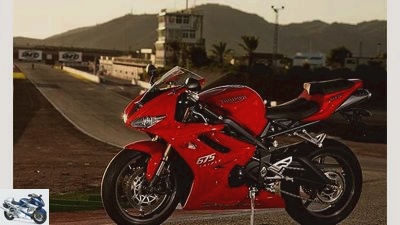
Critchell
Concentrated cargo: the Triumph Daytona 675 presents itself as a potent racing triplet.
A quantum leap like three years ago was not to be expected anyway. Instead, Triumph has carefully, but obviously, revised the successful Daytona 675 in the direction of racing. And that still means: stronger, lighter and faster. Good thing, because the 675 is what it is: a first-class super sports car.
| Technical specifications |
Related articles
-
Second-hand advice Triumph T 595 Daytona
counselor Used purchase Second-hand advice Triumph T 595 Daytona Second-hand advice Triumph T 595 Daytona Hot chair Triumph’s sportiest three-cylinder…
-
fact motorcycles Comparison test: Honda CBR 600 RR, Kawasaki ZX-6R, Suzuki GSX-R 600, Triumph Daytona 675, Yamaha YZF-R6 Comparison test: Honda CBR 600…
-
A comparison of the super sports car MV Agusta F3 675 and Triumph Daytona 675
jkuenstle.de 11 pictures jkuenstle.de 1/11 The Triumph Daytona 675 (right) breaks all prejudices against 600s – at the same time, the elegant and handy…
-
Comparison test Kawasaki Ninja ZX-6R, Triumph Daytona 675, Yamaha YZF-R6
Fact 9 pictures triumph 1/9 Triumph Daytona 675 triumph 2/9 Triumph Daytona 675 triumph 3/9 Triumph Daytona 675 triumph 4/9 Triumph Daytona 675 triumph…
-
PS-TuneUp Triumph Daytona 675 race track tuning
Feulner 17th pictures Andreas Feulner 1/17 PS-TuneUp has set itself the task of forging a good racing athlete into a hot race track sweeper with the…
-
triumph 13th pictures triumph 1/13 Triumph Daytona 675. triumph 2/13 Triumph Daytona 675. triumph 3/13 Triumph Daytona 675. triumph 4/13 Triumph Daytona…
-
Honda CBR 600 RR, Kawasaki Ninja ZX-6R, Suzuki GSX-R 600, Triumph Daytona 675, Yamaha YZF-R6
Jahn 15th pictures Honda 1/15 For the model year 2009 Honda presents a facelifted CBR 600 RR. The well-known 600 cubic four-cylinder has been trimmed for…
-
Premiere Yamaha YZF-R1 + videos
Yamaha 33 pictures Yamaha 1/33 First of all, we will take a look at the device: The variant with a red painted frame looks particularly elegant. Yamaha…
-
Premiere: KTM 990 Super Duke R
Kirn motorcycles Premiere: KTM 990 Super Duke R Premiere: KTM 990 Super Duke R Black Pearl Content of They are particularly valuable: Black pearls from…
-
Triumph Street Triple – Series, Cup, Tuning
K motorcycles Triumph Street Triple – Series, Cup, Tuning Triumph Street Triple – Series, Cup, Tuning Family Day Content of Three sisters: they have a…